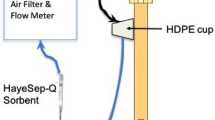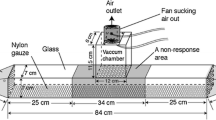Abstract
Social insects that live in large colonies are vulnerable to disease transmission due to relatively high genetic relatedness among individuals and high rates of contact within and across generations. While individual insects rely on innate immune responses, groups of individuals also have evolved social immunity. Hygienic behavior, in which individual honeybees detect chemical stimuli from diseased larvae and subsequently remove the diseased brood from the nest, is one type of social immunity that reduces pathogen transmission. Three volatile compounds, collected from larvae infected with the fungal pathogen Ascosphaera apis and detected by adult honey bees, were identified by coupled gas chromatography-electroantennographic detection and gas chromatography-mass spectrometry. These three compounds, phenethyl acetate, 2-phenylethanol, and benzyl alcohol, were present in volatile collections from infected larvae but were absent from collections from healthy larvae. Two field bioassays revealed that one of the compounds, phenethyl acetate is a key compound associated with Ascosphaera apis-infected larvae that induces hygienic behavior.




Similar content being viewed by others
References
Akino, T., and Yamaoka, R. 1996. Origin of oleic acid corpse recognition signal in the ant, Formica japonica Motschlsky (Hymenoptera: Formicidae). Jap. J. Appl. Entomol. Zool. 40: 265–271.
Arathi, H.S., Burns, I., and Spivak, M. 2000. Ethology of hygienic behavior in the honey bee Apis mellifera L. (Hymenoptera: Apidae): behavioral repertoire of hygienic bees. Ethology 106: 365–379.
ARATHI, H. S., and SPIVAK, M. 2001. Influence of colony genotypic composition on the performance of hygienic behavior in the honey bee (Apis mellifera L.) Anim. Behav. 62:57–66.
ARATHI, H. S., HO, G., and SPIVAK, M. 2007. Inefficient task partitioning among nonhygienic honeybees, Apis mellifera L., and implications for disease transmission. Anim. Behav. 72:431–438.
BEHRINGER, D. C., BUTLER, M. J., and SHIELDS, J. D. 2006. Avoidance of disease by social lobsters. Nature 25:421.
Cook, R.D., and Weisberg, S. 1999. Applied Regression Including Computing and Graphics, John Wiley & Sons, New York, NY. 593 pp. (Arc software available from http://www.stat.umn.edu.floyd.lib.umn.edu/arc/software.html, downloaded on 3 September 2008).
Cremer, S., Armitage, S.A.O., and Schmid-Hempel, P. 2007. Social immunity. Curr. Biol. 17: R693–R702.
Cremer, S., and Sixt, M. 2009. Analogies in the evolution of individual and social immunity. Phil. Trans. R. Soc. B 364: 129–142.
FAHRBACH, S.E., and MESCE, K.A. 2005. “Neuroethoendocrinology”: integration of field and laboratory studies in insect neuroendocrinology. Horm. Behav. 48: 352–359.
Free, J. B., and Winder, M. E. 1983. Brood recognition by honeybee (Apis mellifera) workers. Anim. Behav. 31: 539–545.
Gilliam, M., Taber, S. III, and Richardson, G. 1983. Hygienic behavior of honey bees in relation to chalkbrood disease. Apidologie 14: 29–39.
Gilliam, M., and Vandenberg, J.D. 1997. Fungi, pp. 81–110, in R. A. Morse and K. Flottum (eds.). Honey Bee Pests, Predators and Diseases. Third Edition. A. I. Root Co, Medina, Ohio
Gramacho, K. P., and Spivak, M. 2003. Differences in olfactory sensitivity and behavioral responses among honey bees bred for hygienic behavior. Behav. Ecol. Sociobiol. 54: 472–479.
Howard, D.F., and Tschinkel, W. R. 1976. Aspects of necrophoric behavior in the red imported fire ant, Solenpsis invicta. Behaviour 56: 157–178
HUGHES, W. O. H., EILENBERG, J., and BOOMSMA, J. J. 2002. Trade-offs in group living: transmission and disease resistance in leaf-cutting ants. Proc. Biol. Sci. 269: 1811–1819.
Ibrahim, A., Reuter, G. S., and Spivak, M. 2007. Field trial of honey bee colonies bred for mechanisms of resistance against Varroa destructor. Apidologie 38: 67–76.
Le Conte, Y., Arnold, G., Trouiller, J., Masson, C., and Chappe, B. 1990. Identification of a brood pheromone in honey bees. Naturwissenschaften 77: 334–336
Masterman, R., Ross, R., Mesce, K. A., and Spivak, M. 2001. Olfactory and behavioral response thresholds to odors of diseased brood differ between hygienic and non-hygienic honey bees (Apis mellifera L.). J. Comp. Physiol. A 187: 441–452.
Masterman, R., Smith, B. H., and Spivak, M. 2000. Brood odor discrimination abilities in hygienic honey bees (Apis mellifera L.) using proboscis extension reflex conditioning. J. Insect Behav. 13: 87–101
MILANI, N. 1999. The resistance of Varroa jacobsoni Oud. to acaracides. Apidologie 30: 229–234.
Rothenbuhler, W. C. 1964. Behavior genetics of nest cleaning in honey bees. I. Responses of four inbred lines to disease-killed brood. Anim. Behav 12: 578–583.
Spivak, M. 1996. Honey bee hygienic behavior and defense against Varroa jacobsoni. Apidologie 27: 245–260.
Spivak, M., and Reuter, G. S. 1998. Performance of hygienic honey bee colonies in a commercial apiary. Apidologie 29: 291–302.
SPIVAK, M., and REUTER, G. S. 2001a. Resistance to American foulbrood disease by honey bee colonies, Apis mellifera, bred for hygienic behavior. Apidologie 32: 555–565.
SPIVAK, M., and REUTER, G. S. 2001b. Varroa jacobsoni infestation in untreated honey bee (Hymenoptera: Apidae) colonies selected for hygienic behavior. J. Econ. Entomol. 94: 326–331.
SPIVAK, M., MASTERMAN, R., ROSS, R., and MESCE, K. A. 2003. Hygienic behavior in the honey bee (Apis mellifera L.) and the modulatory role of octopamine. J. Neurobiol. 55: 341–354.
Visscher P. K. 1983. The honeybee way of death: necrophoric behavior in Apis mellifera colonies. Anim. Behav. 31:1790–1801.
WALLNER A. 1999. Varroacides and their determination in bee products. Apidologie 30: 235– 248
Wilson, E. O., Durlach, N. I., and Roth, L. M. 1958. Chemical releasers of necrophoric behavior in ants. Psyche. 65: 108–114
Wilson-Rich, N., Spivak, M., Fefferman, N. H., and Starks, P. T. 2009. Genetic, individual, and group facilitation of disease resistance in insect societies. Annu. Rev. Entomol. 54: 405–423
WOODROW, A. W., and HOLST, E. C. 1942. The mechanism of colony resistance to American foulbrood. J. Econ. Entomol. 35: 327–330.
Author information
Authors and Affiliations
Corresponding author
Rights and permissions
About this article
Cite this article
Swanson, J.A.I., Torto, B., Kells, S.A. et al. Odorants that Induce Hygienic Behavior in Honeybees: Identification of Volatile Compounds in Chalkbrood-Infected Honeybee Larvae. J Chem Ecol 35, 1108–1116 (2009). https://doi.org/10.1007/s10886-009-9683-8
Received:
Revised:
Accepted:
Published:
Issue Date:
DOI: https://doi.org/10.1007/s10886-009-9683-8




